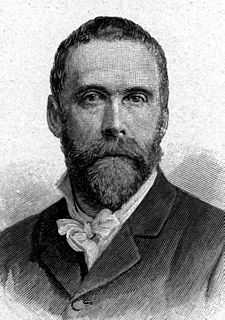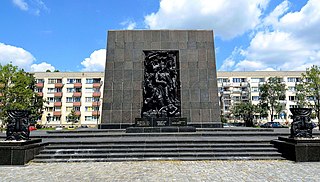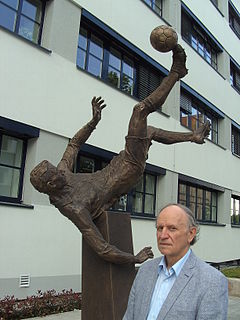
Maya Ying Lin is an American designer and sculptor. In 1981, while an undergraduate at Yale University, she achieved national recognition when she won a national design competition for the planned Vietnam Veterans Memorial in Washington, D.C.

Willy Brandt was a German politician and statesman who was leader of the Social Democratic Party of Germany (SPD) from 1964 to 1987 and served as the chancellor of West Germany from 1969 to 1974. He was awarded the Nobel Peace Prize in 1971 for his efforts to strengthen cooperation in western Europe through the EEC and to achieve reconciliation between West Germany and the countries of Eastern Europe. He was the first Social Democrat chancellor since 1930.

Josef Thorak was an Austrian-German sculptor. He became known for oversize monumental sculptures, particularly of male figures, and was one of the most prominent sculptors of the Third Reich.

The term Kniefall von Warschau, also referred to as Warschauer Kniefall, refers to West German Chancellor Willy Brandt kneeling and giving a moment of silence during a visit to a Warsaw Ghetto Uprising memorial in 1970.
Donald Harcourt De Lue was an American sculptor, best known for his public monuments.

Daniel "Dani" Karavan was an Israeli sculptor best known for site specific memorials and monuments which merge into the environment.

The Topography of Terror is an outdoor and indoor history museum in Berlin, Germany. It is located on Niederkirchnerstrasse, formerly Prinz-Albrecht-Strasse, on the site of buildings, which during the Nazi regime from 1933 to 1945 was the SS Reich Security Main Office, the headquarters of the Sicherheitspolizei, SD, Einsatzgruppen and Gestapo.

Charles Sargeant Jagger was a British sculptor who, following active service in the First World War, sculpted many works on the theme of war. He is best known for his war memorials, especially the Royal Artillery Memorial at Hyde Park Corner and the Great Western Railway War Memorial in Paddington Railway Station. He also designed several other monuments around Britain and other parts of the world.

Nuremberg Zoo is a zoo located in the Nuremberg Reichswald, southeast of Nuremberg, Germany. With an area of 67 hectares, approximately 300 animal species are kept by the zoo.

The Gedenkstätte Berliner Mauer commemorates the division of Berlin by the Berlin Wall and the deaths that occurred there. The monument was created in 1998 by the Federal Republic of Germany and the Federal State of Berlin. It is located on Bernauer Straße at the corner of Ackerstraße and includes a Chapel of Reconciliation, the Berlin Wall Documentation Centre, a 60-metre (200 ft) section of the former border, a window of remembrance and a visitor center.

Syrius Eberle was a German sculptor and art professor.

The Monument to the Ghetto Heroes is a monument in Warsaw, Poland, commemorating the Warsaw Ghetto Uprising of 1943 during the Second World War. It is located in the area which was formerly a part of the Warsaw Ghetto, at the spot where the first armed clash of the uprising took place.

The memorial for the victims of war stands at the mass grave for the Jews who were shot in Novohrad-Volynskyi in the Second World War that began in September 1939. The monument was created by the artist Josef Tabachnyk who makes monuments and sculptures.

Josef Tabachnyk is an artist living in Nuremberg, who specialises in making bronze sculptures of people, animals and abstract forms. His most famous works include Knut the Dreamer, the Willy-Brandt memorial, a statue of Adolf Dassler as well as memorials for victims of war in Saint Petersburg, Zhytomyr, Novohrad-Volynskyi and Slovechne.

The Memorial for the Victims of Fascism, also called Memorial for the Victims of the Concentration Camps or Memorial for the Victims of Fascism in Bogunskiy-Forrest, was erected in 1996 in the district of Boguniya in the city of Schytomyr in Ukraine. The sculpture's creators are the sculptor Josef Tabachnyk and the architect Peter Biryuk.

The Willy-Brandt-Haus in Lübeck is a museum and a memorial to the late politician Federal Chancellor and Nobel Peace Prize Laureate, Willy Brandt, of the Social Democratic Party of Germany (SPD).

The Forced Laborer Memorial "Transit" is a Nuremberg monument. It is located at the Plärrer, a main traffic junction of the Nuremberg city centre, just outside the city wall. The aim is to keep the memory of the fate of the Nuremberg forced laborers during the Nazi era alive.

The Willy-Brandt-Platz is a central square in Frankfurt am Main, Hesse, Germany. Its name was Theaterplatz until 1992, when it was named after Willy Brandt, the former chancellor. It is located between the Main Station and the Altstadt, at the Frankfurter Anlagenring, and is part of the so-called Bankenviertel. Major buildings are the Städtisches Opern- und Schauspielhaus, the municipal theatre that opened in 1963, and the Eurotower skyscraper. Below the square are the U-Bahnhof Willy-Brandt-Platz and the Theatertunnel street tunnel.

The Euro-Skulptur by Ottmar Hörl set up at Willy-Brandt-Platz in Frankfurt am Main, Germany, is one of two copies of the work that have been put on public display. It is a 14-metre (46 ft) tall electronic sign that shows a Euro sign and twelve stars around, weighing 50 tonnes.

The St. Jakobs Memorial is a statue originally erected in 1824 in the Canton Basel, Switzerland in memory of the fallen Swiss soldiers in the Battle of St.Jakob at the Birs of 1444. Due to extensive maintaining costs the government demanded the replacement of the first memorial with one built from a more durable material. In 1872, the current statue, built by the Swiss sculptor Ferdinand Schlöth was erected.



















